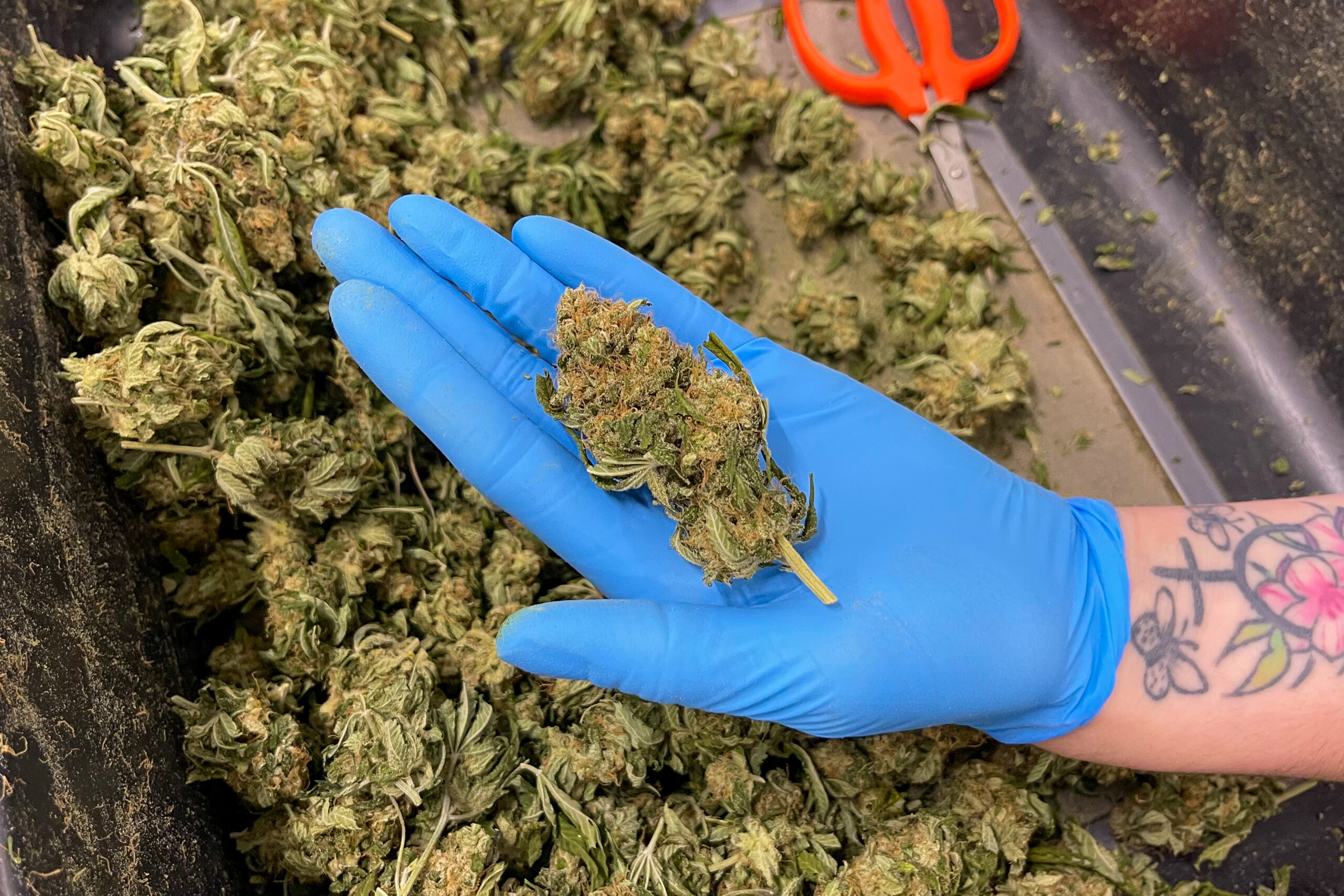12:54
News Story
Hippos Cannabis has a 40,000-square-foot production facility in Vienna, Mo., a town of 600 people that’s just 30 minutes north of Rolla.
Since Missouri’s recreational marijuana sales began in February, they’ve added 25 workers, bringing the total employees to 70 — who come from Vienna or the surrounding communities.
“A lot of the employees were born and raised and went to high school in Vienna, and now they’re all working together,” said Nicholas Rinella, CEO of Hippos which also includes three dispensaries throughout Missouri. “So it’s a real community at the facility.”
Like other companies, Hippos is working on expanding their facility, where they largely make jarred cannabis flower buds and pre-rolled joints, in order to ramp up production and keep marijuana dispensary shelves stocked.
“We didn’t know if Amendment 3 was going to pass,” Rinella said. “Once it did pass, what the industry had expected was a 2.5 times bump in sales. And it ended up being closer to five to six times.”
Missouri’s recreational marijuana sales came in at $91 million for April, according to a report the state released on Friday. That’s up from February’s $71.7 million and on par with March’s $93.5 million — for a total of $256 million in the first three months.
Adding in medical marijuana sales, Missouri hit $350 million in the first three months since the state has been able to sell recreational marijuana.

Yet cannabis business owners say those numbers could be even higher since cultivators and manufacturers like Hippos aren’t working at their maximum capacity.
It could take up to a year to see what Missouri sales are capable of, said Tyler Hannegan, co-owner and chief of operations and sales at Robust Cannabis.
That’s partially because anytime a cannabis business makes changes to their facility, it must get approval from the state regulating agency, the Missouri Department of Health and Senior Services (DHSS).
Since February, DHSS has received more than 80 requests for facility changes, adding to the 40 they already had pending, said DHSS spokeswoman Lisa Cox.
“I don’t think we’ve seen peak numbers yet at all,” Hannegan said of Missouri sales, “just because there’s still cultivation groups that haven’t come online. They’ve just expanded, but they haven’t even been approved.”
Still, Missouri’s market has been among the quickest to rise nationwide.
For Illinois, it took seven months to hit $300 million after beginning adult-use sales in January 2020, with its first year ending at $670 million. Two years later, Illinois ended 2022 at $1.6 billion.
While Missouri is not matching Illinois’ April numbers of $132 million, it is still poised to hit over a billion in its first year.
A year ago, Robust Cannabis had six employees when they opened their 75,000-square-foot greenhouse and manufacturing site in Cuba, Mo., which is an hour south of St. Louis. Now they have 70 workers, who live and often grew up nearby.
The company began tripling its production in January, and they’ve hired about 40 people in the last three months alone.
But they’re still not meeting the state’s incredible demand, said Emily Braun, director of operations and human resources of Robust Cannabis.
“I don’t even think anybody could anticipate that Missouri would be such flower fiends,” said Braun, meaning cannabis flower buds and pre-rolled joints. “Nobody can keep it on the shelves.”
And even if every Missouri company was producing at its max, Braun said, “I don’t even know if it’s enough. It’s just insane.”
Turnaround time

Missouri began recreational marijuana sales three months after voters approved the constitutional amendment to legalize it in November.
That was the second fastest turnaround in the country, just two weeks behind Arizona’s record, according to a report by Brightfield Group cannabis analysis firm in Chicago.
However, now several businesses are needing to expand to keep up with demand, and they can run into some delays there.
Companies submit their construction plans for DHSS’ review and can start the work immediately. Once the project is done, then DHSS inspects the work and hopefully approves it.
“Processing time for these requests under the new rules is dependent on how quickly a facility can implement the changes for which they are seeking approval,” Cox said, “as they may begin construction after making a request. But DHSS can only approve the request once the expansion is ready for inspection.”
Of the total 121 requests DHSS had pending in February, 39 were for cultivation facilities, 38 were dispensaries, 36 were manufacturing sites, seven were transportation and one was for a testing facility.
Of those, 23 have been approved and are ready to go. Cox said 29 are in final review after inspection and should be approved over the course of the next two weeks.
Five are constructed and scheduled for inspection, and DHSS is waiting on 64 to complete construction so that they can conduct an inspection and approve those spaces.
And like the cannabis companies themselves, DHSS is also hiring new employees to keep pace with the growing market.
“DHSS is in the process of hiring a large amount of new staff to handle the increase in workload associated with the new law,” Cox said. “The Division of Cannabis Regulation is about 30% through their hiring plan and expect to be fully staffed by the end of the year.”
The value conversation

With the high demand, Rinella said the industry has seen some price increases. But he said it’s important to remember that two years ago, an eighth of flower – the most common product sold – was at $60 dispensaries.
And at one point, the price dipped as low as $25.
“Right now it’s just really starting to stabilize,” he said. “It looks like things are sitting around the $40 to $45 mark,” which are the average prices at Hippos’ menu.
About 25 years ago on the illicit market, he said an eighth was about $50.
“It’s actually less expensive today to buy it at a dispensary and you have a higher quality,” he said. “You know that the product was all safe and tested.”
Hannegan, who is also co-owner of Feel State dispensary in St. Louis, said he’s seen a rise in prices across the board in Missouri.
“That really is a testament is to some of the dispensaries not having enough flower products,” he said.
Robust and other places have been doing “phenomenally well” in their yields, which helps them keep prices stable.
“There are quite a few that have struggled trying to rush the process and trying to adapt recreational, thus causing some supply issues,” he said.
Jason Nelson, the owner of Swade dispensaries and Sinse Cannabis cultivation, said it’s important that prices don’t shift too much while Missouri’s market is trying to stabilize.
That’s because, Nelson said, customers could easily just go back to their previous dealer.
He’s constantly having conversations with customers about the value of buying from a dispensary versus their off-market dealers who probably don’t know if their products have pesticides, heavy metals and other contaminants.
If prices are stable, Nelson has an edge in that conversation. But if they spike, he said he’s going to lose, especially in “these times of inflation.”
“That value conversation really can’t exist much more than a 15% to 20% dollar amount over the illicit market price,” he said. “While it might ultimately take away from top line revenue, if you overprice and take a short-term gain on top line revenue, you’re gonna risk losing that conversation.”
He’s seen where the “large multi-state operators” took the top-line revenue approach and lost a big segment of their customers who went back to their old dealers.
“We, as responsible and comprehensive operators in Missouri, have to manage that successfully,” he said. “And I think we’re poised to do it.”
Our stories may be republished online or in print under Creative Commons license CC BY-NC-ND 4.0. We ask that you edit only for style or to shorten, provide proper attribution and link to our website. AP and Getty images may not be republished. Please see our republishing guidelines for use of any other photos and graphics.





